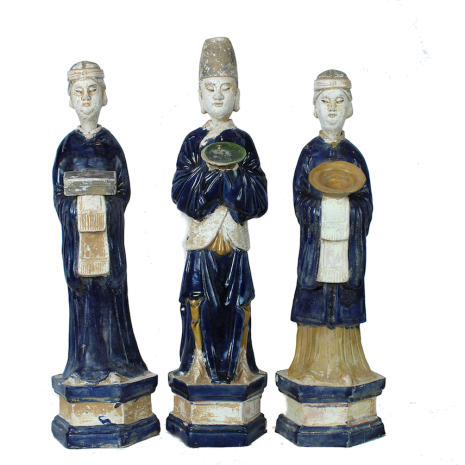Antique Rare Set of Ming Ceramic Attendants, China (3224)
$4,985.00
Ht: 17.9″ W: 4.9″ D: 4.8″ | CALL OR EMAIL FOR SHIPPING INFO
This fine set of three elegant Ming dynasty attendants—one male and two female—are in a unique category of refinement and elegance that reflects the importance and high status of the tomb, the deceased and the family for which they were made. Standing on hexagonal bases with arms folded below their chests and presenting offerings to the deceased, their clothing and parts of the bases have a rare cobalt blue glaze. (Two have yellow glazed areas and all have painted unglazed areas.) Their removable heads are highly detailed and beautifully modeled fitting inside high collars. These figures are presented and sold as a remarkable set reflecting their original presentation and condition.
Description
Earthenware ceramics of all kinds – figures of attendants, musicians and entertainers, miniature furniture, architectural models, animals – included mould made ancestral objects used specifically for burials called mingqi (“bright utensils” in Chinese) and as a form of ancestor-worship provided the dead in their afterlife the comforts they enjoyed when alive. By the Ming, tomb ancestor-figures were limited to the most elite and wealthy. They were produced in two stages: first fired at higher temperatures without a glaze and then glazes and additional pigments were applied and fired at lower temperatures. The result was intense glazes that took on a life of their own in contrast to the unglazed (biscuit) surfaces. The predominant and expensive cobalt blue seen here was selectively used for mingqi for the most elite families. Each one stands on three level hexagonal base. Their clothing and parts of the bases are beautifully colored with a cobalt blue glaze and two have yellow glazed areas. Typical for large Ming attendants, their removable heads are highly detailed and beautifully modeled with long necks that fit securely inside high collars. The heads, ritual cloths, offerings and bases between the blue glazed areas are all unglazed, directly painted on the biscuit and covered with a thin layer of tomb dust. The left female with arms covered by sleeves holds a black unglazed box on an unglazed presentation cloth. Her radiantly glazed robe flows to the top of the plinth covering all but the front of her shoes and she wears a simple low headdress covering her black hair. The taller middle male figure is dressed in elegantly glazed cobalt robes parted at the legs to reveal a lower yellow undergarment falling to the plinth and an unglazed white garment folded at the hips. He wears a high unglazed black hat and holds a green glazed offering plate. The third attendant holds a yellow glazed bowl on an unglazed presentation cloth and wears a shorter beautifully glazed cobalt robe over a yellow glazed lower garment. She wears the same low headdress over her black hair. A pair of similar figures online at the University of Florida Harm Museum has a far less elegant pair described as “male and female servant standing at attention ready to serve their master with a wash basin and towel. “ Our measurement is for the taller central male attendant. These remarkable figures are in excellent condition with original mixed glazed and unglazed parts, small amounts of expected tomb dust and normal minor paint and glaze losses and scratches. One has a loss to extension of the neck but is not visible when inserted into its deep secure collar.
Sources
Albert. E Dien, et. al., The Quest for Eternity, San Francisco, Chronicle Books, 1987.
Harn Museum of Art, Educator Resources, Chinese Funerary Ceramics
.
Additional information
| Period | Antique, Ming Dynasty |
|---|---|
| Date | 15-16th Century |
| Materials and Technique | Ceramics |
| Dimensions (inches) | Ht: 17.875” W: 4.875” D: 4.75” |
| Dimensions (metric) | Ht: 45.40cm W: 12.38cm D: 12.06cm |
| Condition | Excellent, fine patina demonstrating age and use |
| Item Number | 3224ABC-BKEM |
| Width | 12” to 17.9” |
| Shipping Box Size | Oversized. Call 213-568-3030 or email [email protected] for shipping. |






















